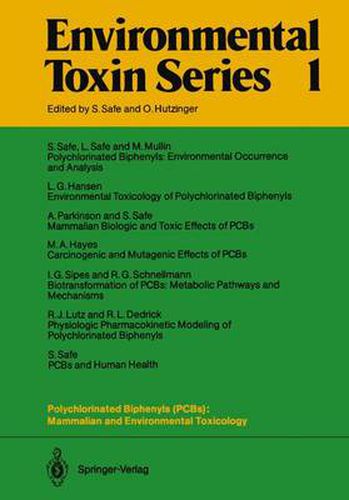Readings Newsletter
Become a Readings Member to make your shopping experience even easier.
Sign in or sign up for free!
You’re not far away from qualifying for FREE standard shipping within Australia
You’ve qualified for FREE standard shipping within Australia
The cart is loading…






This title is printed to order. This book may have been self-published. If so, we cannot guarantee the quality of the content. In the main most books will have gone through the editing process however some may not. We therefore suggest that you be aware of this before ordering this book. If in doubt check either the author or publisher’s details as we are unable to accept any returns unless they are faulty. Please contact us if you have any questions.
Polychlorinated biphenyls (PCBs) have been produced commercially since be fore 1930. They proved to be highly versatile mixtures and their uses continued to expand during the early 1970’s even after the unanticipated world-wide en vironmental contamination had been discovered (Jensen et aI. , 1969; Koeman et aI. , 1969). Over 600,000 metric-tons were produced and/or used in the U. S. during this time and it is estimated that worldwide production totaled about 1,200,000 metric-tons (Table 1). With low acute toxicities (Fishbein, 1974), these mixtures were considered gen erally biologically inactive even though industrial exposure had demonstrated he patic and dermatological effects (Fishbein, 1974; Hansen, 1987). Thus, use and disposal were not carefully monitored and it is estimated that one-third of the world-wide production of PCBs has been released into the global environment (Table 1). Table 1. Estimated production and disposition of PCBs b U. s. a Worldwide 6 6 Production/use 610 X 10 kg 1200 X 10 kg Mobil environmental reservoir 82 400 Static reservoirs In service 340 Dumps 130 Total static 470 800 a NAS, 1979 b Tatsukawa and Tanaba, 1984 2 Environmental Distribution Many countries now impose strict controls on the use and release of PCBs. Re lease into the environment has declined dramatically in the last decade, but con tinued release from reservoirs (Table 1) into burdened ecosystems (Table 2) ap pears inevitable for several more decades (Barros et aI. , 1984).
$9.00 standard shipping within Australia
FREE standard shipping within Australia for orders over $100.00
Express & International shipping calculated at checkout
This title is printed to order. This book may have been self-published. If so, we cannot guarantee the quality of the content. In the main most books will have gone through the editing process however some may not. We therefore suggest that you be aware of this before ordering this book. If in doubt check either the author or publisher’s details as we are unable to accept any returns unless they are faulty. Please contact us if you have any questions.
Polychlorinated biphenyls (PCBs) have been produced commercially since be fore 1930. They proved to be highly versatile mixtures and their uses continued to expand during the early 1970’s even after the unanticipated world-wide en vironmental contamination had been discovered (Jensen et aI. , 1969; Koeman et aI. , 1969). Over 600,000 metric-tons were produced and/or used in the U. S. during this time and it is estimated that worldwide production totaled about 1,200,000 metric-tons (Table 1). With low acute toxicities (Fishbein, 1974), these mixtures were considered gen erally biologically inactive even though industrial exposure had demonstrated he patic and dermatological effects (Fishbein, 1974; Hansen, 1987). Thus, use and disposal were not carefully monitored and it is estimated that one-third of the world-wide production of PCBs has been released into the global environment (Table 1). Table 1. Estimated production and disposition of PCBs b U. s. a Worldwide 6 6 Production/use 610 X 10 kg 1200 X 10 kg Mobil environmental reservoir 82 400 Static reservoirs In service 340 Dumps 130 Total static 470 800 a NAS, 1979 b Tatsukawa and Tanaba, 1984 2 Environmental Distribution Many countries now impose strict controls on the use and release of PCBs. Re lease into the environment has declined dramatically in the last decade, but con tinued release from reservoirs (Table 1) into burdened ecosystems (Table 2) ap pears inevitable for several more decades (Barros et aI. , 1984).